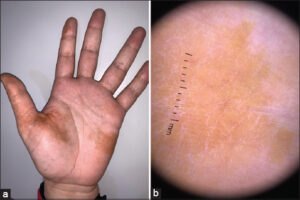Carotenoderma caused by eating habits in the month of Ramadan
Sokaina Chhiti , Zakia Douhi, Sara ELammari, Meryem Soughi, Sara Elloudi, Hanane Baybay, Fatima Zahra Mernissi
, Zakia Douhi, Sara ELammari, Meryem Soughi, Sara Elloudi, Hanane Baybay, Fatima Zahra Mernissi
Department of Dermatology, University Hospital Hassan II Fez, Morocco
Citation tools:
Copyright information
© Our Dermatology Online 2024. No commercial re-use. See rights and permissions. Published by Our Dermatology Online.
Sir,
A thirty-year-old male with no previous pathological history presented with an orange, well-limited, homogeneous coloration of the left palm that began three days before his consultation (Fig. 1a). Dermoscopy revealed a homogeneous, orange pigmentation (Fig. 1b). The rest of the skin and mucous membranes were normally colored. He had no history of eating disorders or abdominal symptoms or changes in urine color. However, the patient reported regular and excessive intake of orange and tomato juice during the month of Ramadan without any notion of ingesting energy drinks. He was advised to reduce the amount of orange and tomato juice. The discoloration faded several days later.
 |
Figure 1: (a)Yellow discoloration of the left palm. (b) Dermoscopy showing a homogenous, orange discoloration of the left palm. |
Carotenemia is a well-known condition characterized by yellowish-orange discoloration of the skin and elevated serum b-carotene [1]. Carotenoids are a large group of naturally occurring pigments, which give fruits and plants their bright yellow, orange, and red hues. More than six hundred carotenoids have been identified, yet the major ones detected in human blood are b-carotene, a-carotene, lutein, b-cryptoxanthin, zeaxanthin [2], and lycopene. The majority of published cases of carotenemia are caused by excessive dietary intake of carotenoid-rich foods, such as carrots, mango, dried seaweed, tomatoes, pumpkin, spinach, yellow corn, butter, eggs, and yellow turnips. Rarely, carotenemia has been associated with systemic diseases, including diabetes mellitus, hypothyroidism, nephrotic syndrome, glomerulonephritis, and primary liver disease [3]. Discoloration is clinically evident once serum carotene levels are three to four times the normal [4]. It predominates on the palms and soles due to the thickness of the stratum corneum, as well as on areas rich in sebaceous glands such as the nasolabial folds. However, palmoplantar involvement may be isolated in localized forms. The mucous membranes are always respected [5]. The elimination of the offending food leads to the normalization of the skin color in two to six weeks.
Consent
The examination of the patient was conducted according to the principles of the Declaration of Helsinki.
The authors certify that they have obtained all appropriate patient consent forms, in which the patients gave their consent for images and other clinical information to be included in the journal. The patients understand that their names and initials will not be published and due effort will be made to conceal their identity, but that anonymity cannot be guaranteed.
REFERENCES
1. Maharshak N, Shapiro J, Trau H. Carotenoderma:A review of the current literature. Int J Dermatol. 2003;42:178-81.
2. Chaparro RS, Carr E, Barron JL. Hypercarotenaemia or hypercarotenoidaemia. Ann Clin Biochem. 2003;40:280-2.
3. Rudd EC, Merika EE. Carotenoderma caused by excessive watermelon and red grapefruit consumption. Clin Exp Dermatol. 2020;45:1093-5.
4. Korsaga Some? N, Zoungrana Oue?draogo A, Konate? I, Oue?draogo Oue?draogo M, Patrice Tapsoba G, Sosso-Kargougou N, et al. Skin disorders in preschool environment in the city of Ouagadougou (Burkina Faso):Epidemiological, clinical and therapeutic aspects. Our Dermatol Online. 2019;10:e31.1-e31.8.
5. Ashique KT. Carotenoderma. Indian Dermatol Online J. 2010;1:52.
Notes
Request permissions
If you wish to reuse any or all of this article please use the e-mail (brzezoo77@yahoo.com) to contact with publisher.
| Related Articles | Search Authors in |
|
 http://orcid.org/0009-0000-6899-8637 http://orcid.org/0009-0000-6899-8637 http://orcid.org/0000-0001-6330-2856 http://orcid.org/0000-0001-6330-2856 http://orcid.org/0000-0002-5942-441X http://orcid.org/0000-0002-5942-441X http://orcid.org/0000-0003-3455-3810 http://orcid.org/0000-0003-3455-3810 |




Comments are closed.